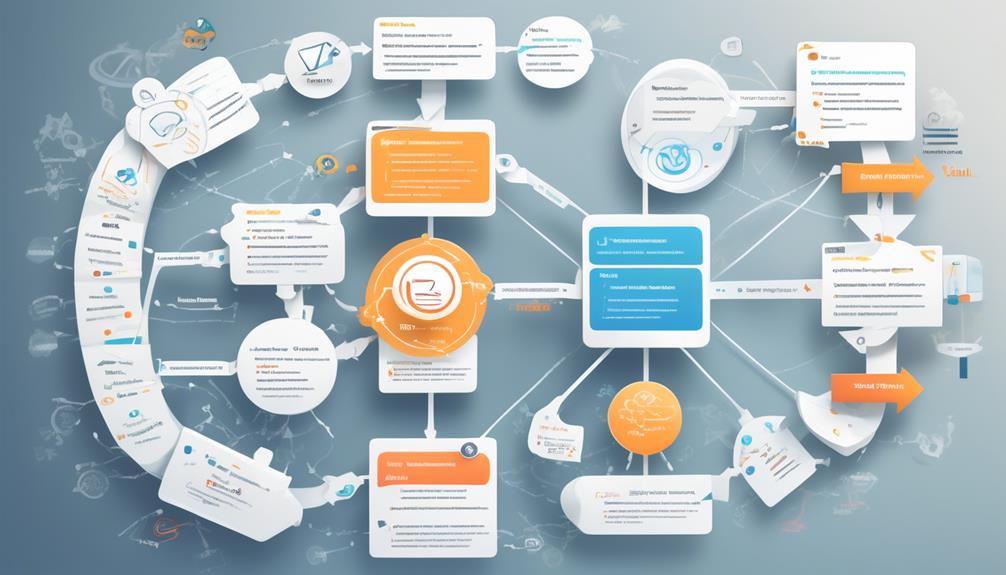Let’s delve into how Gmail Email Automation can enhance our email handling procedures.
With the increasing volume of emails we handle daily, it's become essential to find efficient methods for handling our inbox.
From streamlining repetitive tasks to ensuring that important emails are never missed, Gmail Email Automation holds the potential to revolutionize our email workflow.
But how exactly does it work, and what are the specific benefits it can bring to our daily routines?
Key Takeaways
- Gmail automation saves time and increases productivity by streamlining email management tasks.
- The built-in features of Gmail automation, such as filters, labels, templates, and auto-reply, enhance communication, collaboration, and organization within teams.
- Using a Gmail automation tool supercharges email outreach efforts, streamlines processes, ensures consistent communication, and optimizes email marketing campaigns.
- Integration with Gmail enhances efficiency, productivity, and automation of email outreach, marketing campaigns, shared inboxes, templates, and team collaboration.
Benefits of Gmail Automation
By automating repetitive tasks and streamlining email management, Gmail automation offers significant benefits for saving time and increasing productivity.
Automating email templates and scheduling replies can greatly improve efficiency and consistency in email communications. This means that important emails can be sent out promptly, and responses to frequently asked questions can be automated, freeing up time for more critical tasks.
Additionally, Gmail automation rules can streamline email management by automating tasks such as sorting, replying, and forwarding emails. This reduces the time spent on manual email organization and ensures that emails are prioritized and responded to in a timely manner.
Furthermore, using Gmail automation tools like Gmelius and Zaps can optimize and enhance the native Gmail features for improved automation. These tools offer advanced features that enable users to automate complex workflows, making it easier to manage and process a large volume of emails efficiently.
Moreover, automating Gmail with email workflows and notifications can enhance communication, collaboration, and organization within teams, leading to improved productivity and streamlined operations.
Built-in Gmail Automation Features

Let's talk about the impressive built-in automation features that Gmail offers.
With filters, labels, and auto-reply options, Gmail makes it easy to streamline your email management.
These features can help us save time, stay organized, and communicate more effectively.
Filters
The built-in Gmail filters provide a powerful way to automatically sort and organize your emails based on specific criteria, streamlining your inbox management process.
With Gmail's automation tool, creating filters allows you to set up automation rules to manage incoming emails more efficiently.
By creating filters, you can automatically label, archive, delete, star, or forward incoming messages, among other actions. This feature ensures that emails are sorted into specific folders or labeled appropriately, saving you time and effort.
Filters enable you to prioritize and manage incoming emails effectively, ensuring that important messages are promptly addressed while less urgent ones are organized for later attention.
Labels
Labels in Gmail provide a seamless way to categorize and organize emails efficiently, enhancing the automation process by allowing for personalized email organization.
To automate emails using labels, simply create a new label and choose specific criteria to filter messages. Once created, Gmail can automatically forward, apply the label, or save as new. This streamlines the process and ensures an organized inbox.
Gmail templates can also be associated with labels to further automate and personalize email responses. By leveraging these features, users can significantly improve their email management, productivity, and overall experience.
With the ability to customize and automate various actions based on labels, Gmail offers a powerful tool for mastering email organization and efficiency.
Auto-reply
Maximizing your email productivity, Gmail's auto-reply feature allows for efficient and timely responses to incoming messages. This feature is particularly useful when you're unable to respond manually, ensuring that senders receive acknowledgment or a brief response. To illustrate its usefulness, consider the following scenarios:
| Auto-Reply Scenario | Description | Benefit |
|---|---|---|
| Out of Office | Automatically sends a response when you're away from the office | Notifies senders of your unavailability |
| Thank You Message | Sends a pre-written thank you note for specific types of messages | Saves time and acknowledges the sender |
| Meeting Confirmation | Automatically confirms meeting requests | Ensures timely confirmation |
| Customer Support Queries | Instantly acknowledges receipt of customer support inquiries | Provides immediate assurance |
Using a Gmail Automation Tool

Now, let's talk about how we can take advantage of the automated email features and seamless integration with Gmail using a powerful automation tool.
This tool can supercharge our email outreach efforts by automating responses, actions, and even entire sequences. With the ability to streamline processes and manage email pipelines effectively, we can ensure that our communication is consistent, efficient, and professional.
Automated Email Features
Leveraging a Gmail automation tool can significantly streamline email communication processes and boost productivity. By utilizing automated email features, such as templates and shared inboxes, users can save time, ensure consistency in communications, and enhance workflow automation. These automation features not only simplify email writing but also enable users to create standardized templates and variables for various types of communications. This functionality is particularly advantageous for teams working within Google Workspace, as it allows for improved accessibility and effectiveness of Gmail's native tools. By incorporating automation features, users can optimize their email marketing campaigns and internal communications, leading to increased efficiency and productivity. The table below summarizes the key automated email features available through Gmail automation tools.
| Automated Email Features | Description | Benefits |
|---|---|---|
| Templates | Pre-designed email formats | Time-saving, consistent messaging |
| Shared Inbox | Collaborative email management | Enhanced teamwork, streamlined communication |
| Workflow Automation | Automated email workflows | Increased efficiency, improved productivity |
Integration With Gmail
Integrating a Gmail automation tool can enhance the efficiency and effectiveness of email outreach, optimizing the functionality of Gmail's native tools for streamlined communication and productivity.
By integrating Gmail with automation tools like Gmelius, accessibility and efficacy can be increased, improving the overall productivity of email marketing campaigns and internal communications.
This integration allows for the automatic management of shared inboxes, Google templates, and team collaboration, ultimately streamlining the email outreach process.
The seamless integration of Gmail and automation tools provides a powerful solution for optimizing email workflows, making it easier to manage and automate various tasks within the Gmail platform.
This not only saves time but also ensures that email outreach is conducted in a more organized and effective manner.
Email Sequencing and Drip Campaigns

To maximize customer engagement and guide leads through the sales funnel, automated email sequencing and drip campaigns provide strategic and targeted communication over time.
With a Gmail account, you can create and send emails automatically, saving time and increasing productivity.
Email sequencing allows you to schedule a series of messages to be sent based on specific time intervals or triggers, ensuring that your leads receive timely and relevant content.
Drip campaigns, on the other hand, enable you to deliver a sequence of pre-written emails to contacts, nurturing them and moving them through the sales process.
By leveraging these capabilities, you can effectively nurture leads, build relationships, and guide prospects toward conversion.
These automated strategies not only streamline your communication process but also significantly improve engagement and conversion rates.
Set up Gmail Filters

As we optimize our Gmail account for efficient email management, the next step is to set up Gmail filters to automatically organize and manage incoming emails. By creating filters, we can streamline our inbox and prioritize important messages, ultimately saving time and improving organization. Here's how to make the most out of Gmail filters:
- Specify criteria for the filter, such as sender, subject, or keywords, and define actions like labeling, archiving, or forwarding.
- Create filters from the search bar, opened emails, or in the settings menu to streamline email management.
- Automate email sorting and labeling by using filters to categorize and prioritize important messages.
- Save time and improve organization by leveraging Gmail filters for efficient email management.
With these steps, we can take control of our inbox and ensure that important emails are promptly attended to.
Setting up Gmail filters is a powerful way to manage the influx of emails that Gmail accounts receive, allowing us to focus on what matters most.
Create an Email Folder System With Labels

Creating an efficient email folder system with labels in Gmail can significantly enhance your email organization and productivity. By utilizing labels, you can categorize and organize emails effectively, making it easier to access and sort through your inbox.
To streamline this process, create filters to automatically label incoming emails based on specific criteria. This automation can save time and enhance email organization, allowing you to focus on more critical tasks.
Setting up an automated folder system using labels not only improves productivity but also ensures that important emails are easily accessible within the labeled folders.
Google offers a seamless integration of its services, allowing you to connect Gmail with Google Calendar, Google Sheets, and more. This integration enables you to create templates for emails, further optimizing your workflow.
With the ability to filter messages and automate the labeling process, you can take full advantage of Gmail's features to establish a well-organized email folder system. By implementing these strategies, you can effectively manage your inbox, stay organized, and boost your overall productivity.
Build Gmail Templates

Let's streamline our email workflow by building Gmail templates to save time and ensure consistency in our communications. With personalized email templates, inside your Gmail inbox, we can take back control of our repetitive tasks and increase productivity. By creating new email templates, we can significantly improve our email management and automation.
Here are some key benefits of using Gmail templates:
- Save time: Building Gmail templates allows us to quickly respond to common inquiries and eliminate the need to retype similar messages repeatedly.
- Professionalism: Consistency in our email communications helps maintain a professional image and ensures that important details aren't overlooked.
- Personalization: We can add a personal touch to our templates by using variables for customization, making our emails feel more authentic and tailored to the recipient.
- Team collaboration: Sharing email templates with team members fosters streamlined communication within our organization, promoting cohesion and unified messaging.
Can the Email Automation Features in Clickfunnels be Compared to Gmail’s?
When it comes to clickfunnels email automation tutorial, it offers a wide range of features for managing email campaigns, but it cannot be compared to Gmail’s functionality. While Clickfunnels is great for marketing funnels, Gmail excels in traditional email communication and management.
Use Auto-Replies to Automate Gmail

When automating your Gmail inbox, leveraging auto-replies can efficiently manage incoming emails and maintain effective communication with minimal effort.
Using auto-replies in Gmail allows us to automate responses to emails when we're away or busy, ensuring that senders receive acknowledgment and understand our expected response times. We can customize these auto-replies with specific messages and durations, tailoring our responses to different types of emails and situations. This helps us maintain professionalism and manage expectations for both senders and recipients.
Additionally, by automating follow-ups and inquiries with personalized auto-responses, we can ensure that important communications aren't overlooked or delayed. With the ability to schedule auto-replies for specific times and dates, we can further streamline our communication processes and manage our inbox more effectively. This feature can be particularly useful when coordinating with team members or when handling a high volume of emails in Gmail.
Frequently Asked Questions
Can I Automate Emails in Gmail?
Yes, we can automate emails in Gmail. It's an efficient way to streamline our outreach and marketing efforts. By setting up automated sequences and filters, we can save time and increase our productivity.
With the right tools, like Gmelius, we can optimize Gmail's native features for even better automation. It's a game-changer for managing our workload and improving our email organization.
Does Google Have an Email Automation Tool?
Yes, Google offers an email automation tool called Gmail's native automation tools. It can streamline outreach and internal communications.
Gmelius can optimize and enhance these features, allowing for more advanced automation. This can save time and improve consistency in email marketing campaigns.
With the help of these tools, Gmail sequences and drip campaigns can be automated, making email communication more efficient and effective.
Can Power Automate Send Emails From Gmail?
Yes, Power Automate can send emails from Gmail.
We've successfully integrated it to streamline our email communication.
It allows us to automate the sending of emails based on specific triggers or conditions, enabling seamless email automation and communication.
It's a powerful tool for enhancing productivity and efficiency in managing email correspondence through Gmail.
How Do I Automate Weekly Emails in Gmail?
To automate weekly emails in Gmail, we schedule recurring emails using the 'Schedule send' feature.
We compose the email, then click the arrow next to the 'Send' button, and select 'Schedule send.'
This allows us to choose the date and time for the email to be sent out weekly.
It's a powerful tool, as research shows that scheduled emails have a higher open rate, increasing the likelihood of engagement.
Conclusion
In conclusion, Gmail email automation is like having a personal assistant organizing and managing your inbox. It's the key to unlocking a more efficient and productive email workflow.
Just like a well-oiled machine, automation in Gmail keeps everything running smoothly, allowing you to focus on more important tasks.
Embrace the power of automation and watch as your email game reaches new heights.









